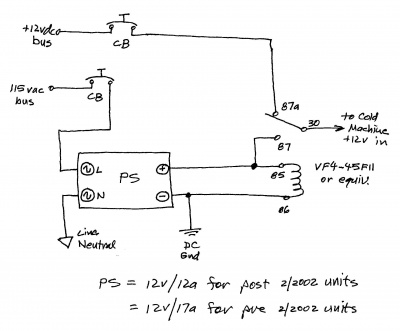Running your 12 VDC fridge on 120 VAC shore power
By John Nixon
First, a little background and history of the Adler-Barbour compressor. Prior to early 2000, all the compressors were fixed speed, brush commuted motors that had a very nasty current spike when the compressor started, but also were very electrically noisy while they were running. The installation manual for these units made a strong point of using big wire from the battery and the fact that you had to have a battery on the feed circuit to help "absorb" the current feedback of the motor back into the voltage source. Upon starting, the peak starting current was in the neighborhood of 17 amps for a couple of hundred milli-seconds. However, my discussions with the engineering folks back then (pre-WAECO) confirmed that with a reasonably "stiff" power supply ( i.e., AC-to-DC power supply ) there was no reason that the compressor wouldn't be happy without a battery in the feed circuit. Of course, I had already tried it by then and knew that to be the case, but it made me feel better having them agree with me.
I used a 250w 12 volt nominal switching power supply with the output voltage set at about 13 volts, which meant that I had about 19 amps available. I used this from the end of 2002 with no problems on my Stamas 44, and the next owner is still using it. The power supply had a cooling fan that ran all the time, and the fan quit after about 3 years. However, since the run current of the compressor was only about 5 amps, the cooling fan wasn't really necessary anyway, and it wasn't an issue. However, the supplier of that power supply no longer carries or makes that power supply, so to duplicate what I did will require some adaptations (at least at a reasonable price).
For the post-2/2000 Cold Machines, the compressor was changed to a variable speed brushless motor in a slightly larger and more efficient compressor, the Danfoss BD50. The variable speed motor starts "softly", and the maximum start current is less than 10 amps. This means that a 150w power supply provides ample reserve to start the compressor, and really coasts along at the 4 to 5 amp run current. The motor also runs more electrically "quiet", which is a very good thing if you have other radio receivers on the boat. This is what I have now on Otra Vez.
For change-over from AC to DC power, I use a standard SPDT 30 amp automotive relay with the relay coil power by the AC power supply. The common terminal of the relay goes to the compressor, the NC contact of the relay goes to the DC feed circuit breaker, and the NO contact of the relay goes to the output of the AC power supply. If the AC power supply is powered up, the compressor runs from shore power; if not, it runs from the house battery bank. When I'm away from the boat with the charger turned off, I leave the fridge DC power turned off at the distribution panel: if shore power goes away, I don't want the batteries run down just to keep the beer and bottled water cold for a few days.......
The power supplies I have used on both the Stamas and the current C34 both came from www.mpja.com. The 150w power supply I use for the newer compressor is part number 16020 PS and costs $40.75. If you have an older compressor, you can use a pair of the same units in parallel after carefully setting the outputs to have equal voltages before tying the outputs together. If you want to pay more and have a better warranty, you can use part number 709-S150-12 from www.mouser.com at $57.96 each. I should note that the cheap units from MPJA have worked without a hick-up for 5 years and counting being turned on 24/7.
Postscript
After looking over my original notes on the subject, I determined that the original 250w power supply that I used with my older Cold Machine compressor ( pre-2000 vintage ) was rated as 12v/17a. I also noted that I had adjusted the output voltage up to about 13.2 volts for maximum efficiency for the compressor. The 17a current rating is a continuous rating, and this power supply easily handled the substantial starting load surge of the older compressor.
Based upon this information, there are actually two better options for power supply selection for the pre-2000 compressors. If you don't mind configuring a pair of units for parallel operation, you can use a pair of 100w units from www.mpja.com, part number PS1-100W-SF12 at $32.80 each. If you would rather have a single unit, use a 240W unit from www.jameco.com, part number 137649 at $106.85. This unit has a 2 year warranty and a cooling fan that only runs on demand, which in this application will be almost never.
